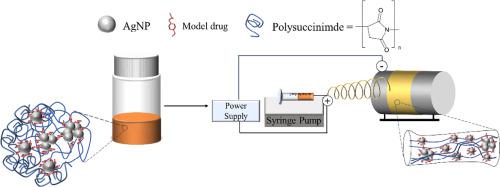Journal of Molecular Liquids ( IF 5.3 ) Pub Date : 2020-10-18 , DOI: 10.1016/j.molliq.2020.114575 Dóra Barczikai , Viktória Kacsari , Judit Domokos , Dóra Szabó , Angela Jedlovszky-Hajdu

|
In recent decades, wound dressings have evolved from the simple gauze to sophisticated, carefully designed functional materials which can enhance wound healing and eliminate bacterial infections endangering the wounded area. With an increasing number of multidrug-resistant strains, bacterial overgrowth of the injured area poses a serious risk that can lead to severe conditions. Nanoparticles can exhibit remarkable antibacterial properties thus incorporating them into biocompatible matrices, effective antibacterial wound dressings can be fabricated. Utilizing electrospinning, nanoparticles could be easily incorporated into fibrous polymer meshes. Next to nanoparticles, electrospinning allows the simultaneous encapsulation of small molecules as well, resulting in complex nanocomposite meshes exhibiting antibacterial and anti-inflammatory and/or analgesic properties. In the manuscript, we present a one-pot method for the synthesis of silver nanoparticles (AgNP) in the presence of polysuccinimide (PSI) and a small molecule drug (paracetamol), followed by the fabrication of an antibacterial wound dressing system. Thorough characterization of both the AgNP-containing colloidal system and the meshes were performed. Results reveal the stabilizing effect of PSI and paracetamol enhancing the formation of a monodisperse colloidal system. Mechanical studies confirm the reinforcing effect of silver-nanoparticles, and antibacterial evaluation proves the applicability of the meshes. Drug-release measurement shows prolonged three-step release kinetics.
中文翻译:

银纳米颗粒与常用抗炎药在聚氨基酸衍生物纤维网中的相互作用
近几十年来,伤口敷料已从简单的纱布演变成经过精心设计的精密功能材料,可增强伤口愈合能力并消除危害伤口部位的细菌感染。随着多药耐药菌株数量的增加,受伤区域的细菌过度生长构成了严重风险,可能导致严峻条件。纳米颗粒可以表现出显着的抗菌性能,因此将它们掺入生物相容性基质中,可以制造出有效的抗菌伤口敷料。利用静电纺丝,纳米颗粒可以很容易地掺入纤维状聚合物网中。除了纳米粒子,静电纺丝还可以同时封装小分子,导致复杂的纳米复合材料网片具有抗菌,消炎和/或止痛作用。在手稿中,我们提出了在聚琥珀酰亚胺(PSI)和小分子药物(扑热息痛)存在下一锅法合成银纳米颗粒(AgNP)的方法,然后制造了抗菌伤口敷料系统。对含AgNP的胶体系统和网孔都进行了彻底的表征。结果表明,PSI和扑热息痛的稳定作用增强了单分散胶体系统的形成。力学研究证实了银纳米颗粒的增强作用,抗菌评估证明了网片的适用性。药物释放测量显示延长的三步释放动力学。我们提出了一种在聚琥珀酰亚胺(PSI)和小分子药物(扑热息痛)存在下合成银纳米颗粒(AgNP)的一锅法,然后制作了抗菌伤口敷料系统。对含AgNP的胶体系统和网孔都进行了彻底的表征。结果表明,PSI和扑热息痛的稳定作用增强了单分散胶体系统的形成。力学研究证实了银纳米颗粒的增强作用,抗菌评估证明了网片的适用性。药物释放测量显示延长的三步释放动力学。我们提出了一种在聚琥珀酰亚胺(PSI)和小分子药物(扑热息痛)存在下合成银纳米颗粒(AgNP)的一锅法,然后制作了抗菌伤口敷料系统。对含AgNP的胶体系统和网孔都进行了彻底的表征。结果表明,PSI和扑热息痛的稳定作用增强了单分散胶体系统的形成。力学研究证实了银纳米颗粒的增强作用,抗菌评估证明了网片的适用性。药物释放测量显示延长的三步释放动力学。然后制造抗菌伤口敷料系统。对含AgNP的胶体系统和网孔都进行了彻底的表征。结果表明,PSI和扑热息痛的稳定作用增强了单分散胶体系统的形成。力学研究证实了银纳米颗粒的增强作用,抗菌评估证明了网片的适用性。药物释放测量显示延长的三步释放动力学。然后制造抗菌伤口敷料系统。对含AgNP的胶体系统和网孔都进行了彻底的表征。结果表明,PSI和扑热息痛的稳定作用增强了单分散胶体系统的形成。力学研究证实了银纳米颗粒的增强作用,抗菌评估证明了网片的适用性。药物释放测量显示延长的三步释放动力学。抗菌评估证明了该网的适用性。药物释放测量显示延长的三步释放动力学。抗菌评估证明了该网的适用性。药物释放测量显示延长的三步释放动力学。











































 京公网安备 11010802027423号
京公网安备 11010802027423号